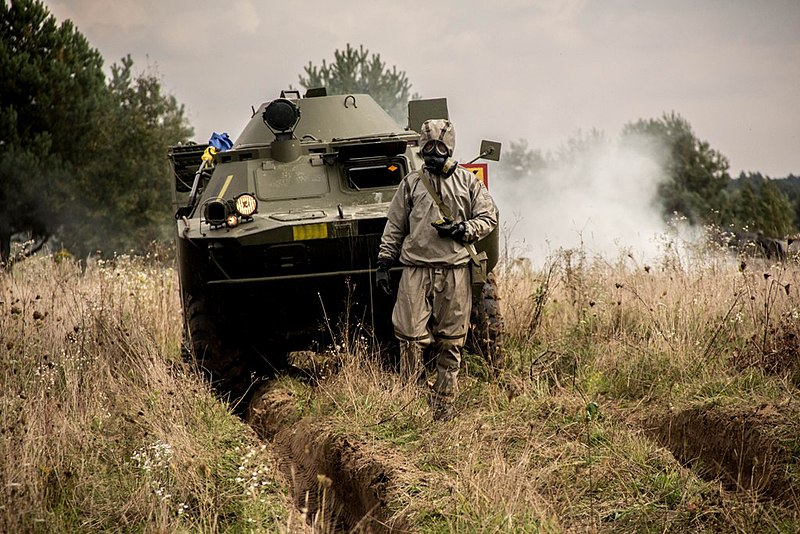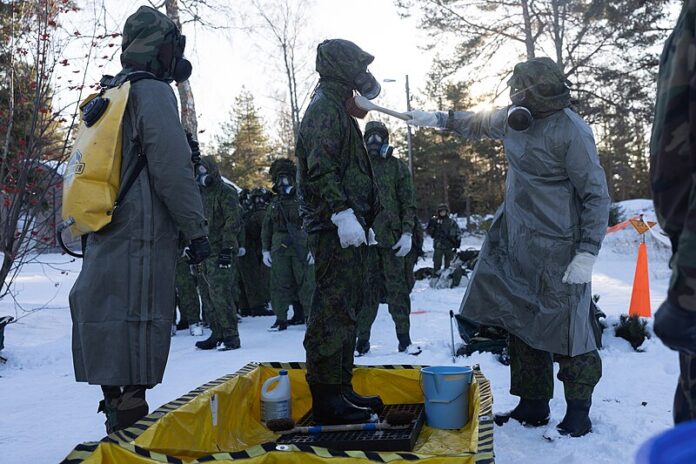By Camille Bensiam
Camille Bensiam briefly reviews the objective, functioning, deployments, and future of NATO’s Combined Joint CBRN Defence Task Force.
The aim of the Combined Joint CBRN Defence Task force concerns protecting, preventing, and recovering from weapon of mass destruction attacks and other possible CBRN events. It is a NATO deployable asset composed of a CBRN Defence Battalion and a CBRN Joint Assessment Team, and can be deployed in five to 20 days.
The CBRN Defence Battalion is specifically trained to respond to CBRN events in armed conflict or in times of crisis. It deals with attacks or incidents that have been or tried to be perpetrated against a NATO member, its territory, or its forces. The Defence Task Force is under the command of the Supreme Allied Commander Europe (SACEUR).
Creation and Functioning
The Battalion and Joint Assessment Team were created in 2003 after the NATO Prague Summit of 2002. It became fully operational on June 28, 2004. More than 20 allies participated on a voluntary basis, but only eight countries assumed leadership of the Defence Task Force on a twelve-month rotary, for example France and Germany. About eight to ten allied countries contributed voluntarily to training together. Moreover, in 2010, the NATO Combined Joint CBRN Defence Task Force welcomed a partner country for the first time, Ukraine, after completing an evaluation and certification.
Training Overview
The training of the Combined Joint CBRN Defence Task Force has been invaluable in knowledge sharing between NATO allies, and most recently in integrating partner countries such as Ukraine.
The Combined Joint CBRN Defence Task Force operates in various territories and contexts. Firstly, it helped during the Olympic Games in Athens in 2004, and at the NATO Summit in Riga in 2006. Then, during the Summer Shield XII training exercise in 2015 in Latvia, a multinational CBRN defense platoon and a decontamination unit were established under German command. Furthermore, the training included a Latvian CBRN reconnaissance element and a water purification unit from Luxembourg. Additionally, the Combined Joint CBRN Defence Task Force was deployed to contain the spread of COVID-19 in 2020.
More recently, SACEUR tasked the Joint CBRN Defence Centre of Excellence to provide training to Ukraine’s first responders. The week of training took place in April 2024 and involved translators and interpreters to aid knowledge transfer.
During the Coronat Mask exercise in June 2024, more than eight hundred CBRN specialists from thirteen NATO countries trained in the Czech Republic. It was the largest CBRN exercise in Europe and focused on interoperability during crisis response and consisted of four multinational training units.

Future of the Defence Task Force
As the geopolitical environment has intensified, the Combined Joint CBRN Defence Task Force’s capabilities have been revised on three occasions. The last revision occurred in 2018 to integrate lessons learned during deployments, as well as to consider the evolving security environment. A reinforcement policy was also approved in 2019.
As the security environment has changed since 2019, the alliance’s approach has evolved. For example, a comprehensive assistance package was launched in 2016, but it was updated during NATO’s 2022 Madrid summit after the full-scale Russian invasion of Ukraine. From 2022, it included short term non-lethal assistance such as CBRN detectors and protection. On the top of that, NATO’s CBRN defense policy was renewed in 2022, with the last one dating from 2009.
The NATO Framework Nations Concept CBRN Defence Cluster
The Framework Nations Concept (FNC) CBRN Defence Cluster began in 2014 as a way for European allies to expand and organize capabilities to better promote interoperability. Germany led the development of CBRN Defence Cluster, with the participation of other members of the alliance. After two years of negotiation, the FNC became a means for European allies to bolster their capacities without the direct involvement of the United States, but U.S. integration offers greater capacities such as U.S.- led training and improved readiness.
The U.S. then expanded the network of countries they worked with and empowered regional leaders. Germanyhas previously provided training to allies such as Netherlands and France, and non-NATO countries like Austria have hosted exercises that include U.S. elements. This has furthered U.S. goals for greater deterrance against Russia’s CBRN threats. The FNC also helps identify which countries may be weaker in their CBRN capabilities, and therefore enables these countries to better train with other European allies and partners.

Conclusion
The CBRN Joint Defence Task Force is a NATO deployable asset that has been operational since 2004. However, not every ally is involved in the group, and not every ally leads it. Even if twenty allies have been able to integrate with each other, only eight allies have been able to lead. This illustrates a discrepancy between allies’ capabilities. Moreover, the Combined Joint CBRN Defence Task Force can include partners in training exercises to help them improve their threat response capabilities, and thus far two partners have been integrated: Austria and Ukraine.
The Framework Nations Concept CBRN Defence Cluster was created to enable the alliance to better identify which nations’ capabilities may be lacking, thereby aiding targeted improvements and reinforcements to plug weaknesses. Eventual U.S. integration allowed the FNC Defence Cluster to increase its overall readiness.
Given that the Combined Joint CBRN Defence Task Force is a deployable asset, and therefore does not operate 24/7, readiness is of particular importance. Indeed, most recent trainings have taken place in the east of the alliance, signalling the need to deter Russian aggression and to respond to it when the need arises.
Allies must adapt to threats and strategies from enemies, and NATO’s CBRN Joint Defence Task Force plays an important role in this constantly evolving mission.
Camille Bensiam is a Defense and Security Analyst at NCT Consultants, where she supports the organization of CBRN training events and conducts research on military equipment, strategic innovation, and defense industry competitors. She holds a strong academic and practical background in European defense policy and international security. Camille previously served as a Blue Book trainee at the European Commission’s DG DEFIS, contributing to the implementation of the European Defence Fund and mapping defense innovation across EU Member States. She has also worked as a Research Assistant at FINABEL – the European Army Interoperability Centre – where she published analytical papers on EU-NATO cooperation in Ukraine, the EU-Egypt partnership, and joint European defense initiatives such as FCAS and MGCS.





